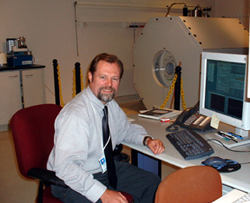Researchers have found that a common anticonvulsant drug improved cognitive function and appeared to restore nerve cells in the brains of patients with HIV-related dementia. The results of the Phase I clinical trial are published in the March issue of the scientific journal, “Neurology.”
The University of Rochester School of Medicine and UNMC collaborated on the pilot study, which was funded by the National Institute of Mental Health.
 |
Harris Gelbard, M.D. |
“This shows that a common, inexpensive drug gets into the brain, and may, in fact, have a real benefit in restoring cognitive function in patients with HIV-related dementia, and perhaps other neuro-inflammatory diseases such as Alzheimer’s,” said Harris Gelbard, M.D., professor of neurology at the University of Rochester Medical Center and the study’s principal investigator.
The clinical trial results help prove a theory developed four years ago at UNMC.
“We began studying the molecules and proteins inside the nerve cell to find out whether this class of drug could change how the nerve cell functions and protect it from injury and death in a toxic inflammatory environment,” said Howard Gendelman, M.D., director for the Center for Neurovirology and Neurodegenerative Disorders at UNMC.
 |
Howard Gendelman, M.D. |
“We’re very excited by what we found,” said Dr. Gendelman, professor and chairman of the UNMC Department of Pharmacology and Experimental Neuroscience. “Most importantly, the neuroprotection from valproic acid we found in patients with HIV-related dementia may have applications to Parkinson’s disease, Alzheimer’s disease and Amyotrophic Lateral Sclerosis, where inflammation plays a key role in neurodegeneration.”
Taking an idea from the laboratory bench to the patient bedside is called translational research, a slow and painstaking process. “It’s difficult and obstacle-prone,” Dr. Gendelman said, “but when the results bear fruit, it’s exceptionally rewarding.”
Although the pilot study group was small, the results are so encouraging the research group will move ahead with a Phase II clinical trial, Dr. Gelbard said.
 |
Michael Boska, Ph.D. |
“The earliest sign of a brain disorder like HIV-related dementia is a change in metabolism of the brain’s nerve cells,” Dr. Boska said. “By using high-resolution magnetic resonance spectroscopy (MRSI), we were able to show a reverse change in metabolism in the brains of those patients taking valproic acid. That was a good indication this therapy was successful.”
Prior clinical trials aimed at protecting neurons from HIV-related injury have been unsuccessful, and the neuro-scientific community at large is closely watching the progress of this research.
“Dr. Gelbard and his colleagues have dispelled many concerns that had been previously raised regarding valproic acid use in HIV-infected persons, showing that the drug appears to be safe, well tolerated and does not affect anti-retroviral efficacy,” said Joseph R. Berger, M.D., chairman of neurology at the University of Kentucky College of Medicine.
Anti-retroviral therapy is the standard drug treatment for HIV and AIDS. While extremely effective at controlling the virus in the patient’s body, this therapy can’t prevent the virus from producing toxic effects in the brain.
Many HIV and AIDS patients are living significantly longer, more productive lives, but HIV-related dementia is a growing public health concern and a very common neurological illness in people aged 25 to 50. It’s estimated up to 25 percent of the 50 million HIV patients worldwide will live long enough to develop HIV-related dementia.
“The University of Rochester and UNMC have accomplished something remarkable,” Dr. Gendelman said. “We’ve gone from bench to bedside in just two years. And with further clinical studies, we hope to prove we can develop useful therapies more rapidly and efficiently for HIV-related dementia and perhaps for other neurological conditions as well.”
Dr. Gendelman cited Huanyu Dou, M.D., instructor, Department of Pharmacology and Experimental Neuroscience, for playing a key role in implementing the research idea into action and a successful conclusion.